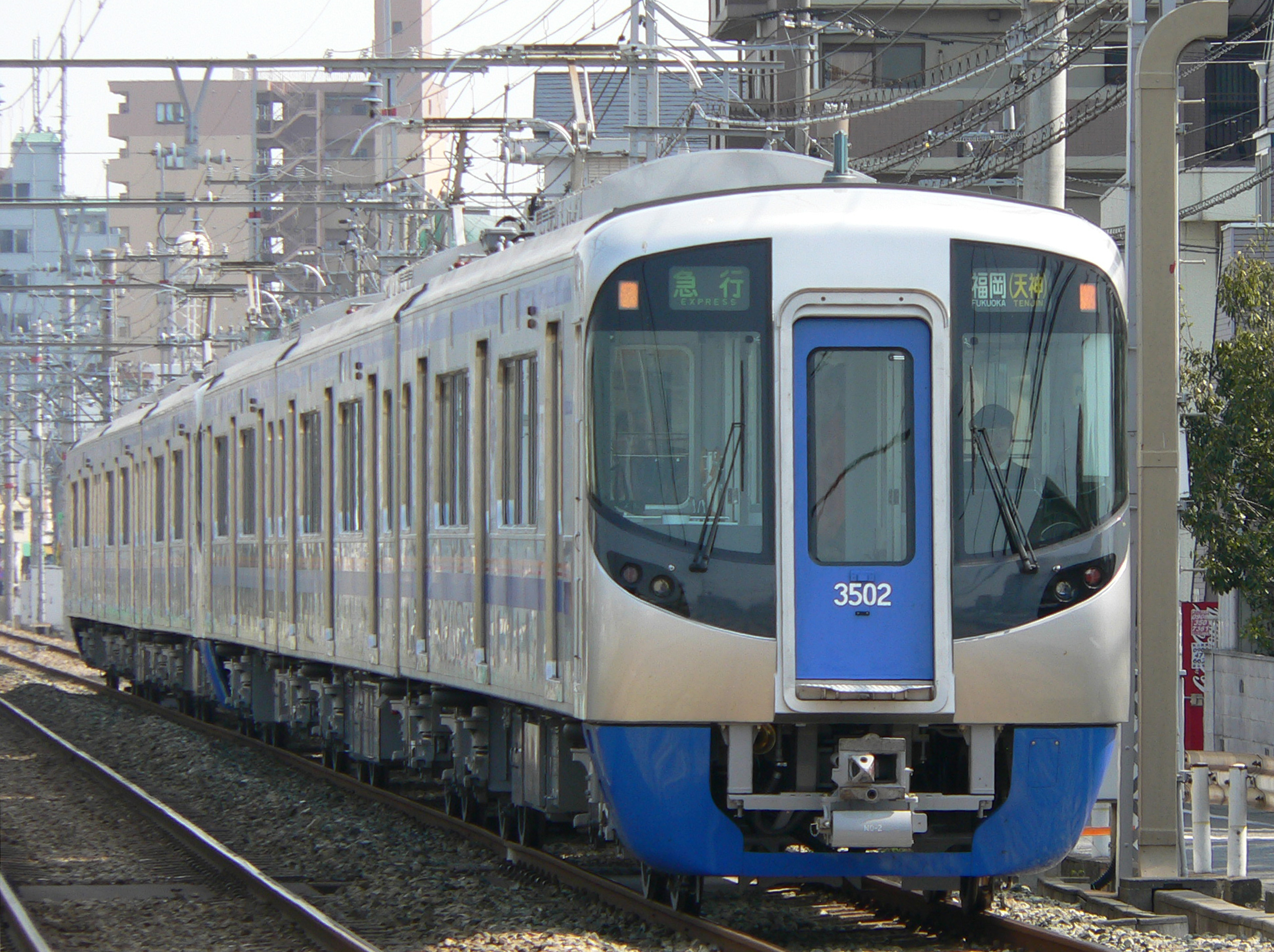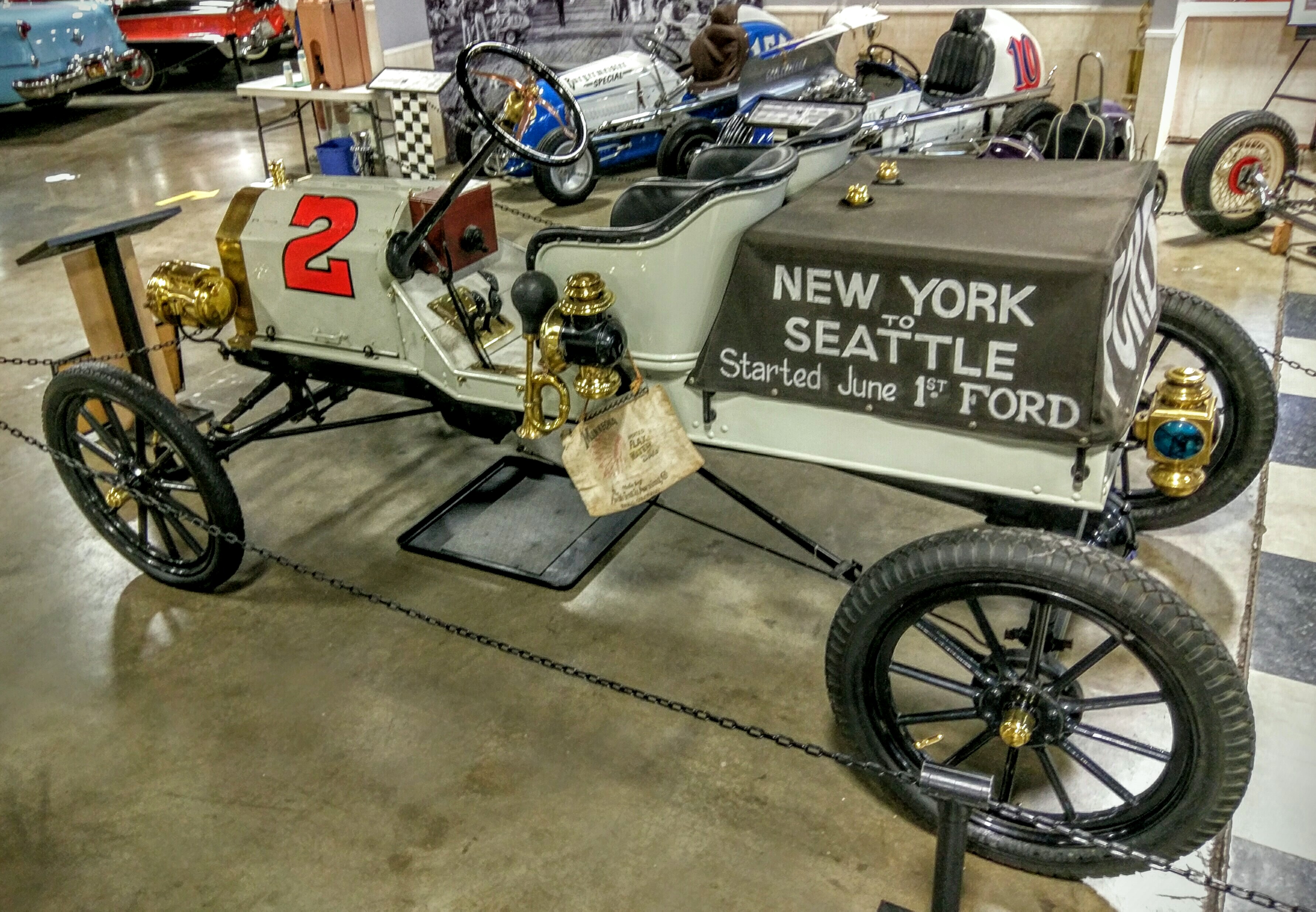|
Nishitetsu 8000 Series
The was an electric multiple unit (EMU) train type that was operated by the private railway operator Nishi-Nippon Railroad (Nishitetsu) in Japan on the Nishitetsu Tenjin Ōmuta Line from 1989 to 2017. Design Six 8000 series trains were built by Kawasaki Heavy Industries in 1989; the first three sets were constructed in February 1989, with the other three sets constructed in April the same year. Unlike most trains made during this period, the 8000 series uses resistor control, something which would have been classified as obsolete during the time due to the advent of the variable-frequency drive. Initially, there were plans for the 8000 series to use a control method other than resistor control, but due to a combination of factors, the idea was soon dropped. Operations The 8000 series trains operated on the Nishitetsu Tenjin Ōmuta and Dazaifu Lines and were mainly used on limited express services. Formations The six six-car sets are formed as follows with four motored ("M") ... [...More Info...] [...Related Items...] OR: [Wikipedia] [Google] [Baidu] |
Kawasaki Heavy Industries
is a Japanese Public company, public multinational corporation manufacturer of motorcycles, engines, Heavy equipment (construction), heavy equipment, aerospace and Military, defense equipment, rolling stock and ships, headquartered in Minato, Tokyo, Minato, Tokyo, Japan. It is also active in the production of industrial robots, gas turbines, pumps, boilers and other industrial products. The company is named after its founder, Kawasaki Shōzō, Shōzō Kawasaki. KHI is known as one of the three major heavy industrial manufacturers of Japan, alongside Mitsubishi Heavy Industries and IHI Corporation, IHI. Prior to the World War II, Second World War, KHI was part of the Kobe Kawasaki ''zaibatsu'', which included JFE Holdings, Kawasaki Steel and K Line, Kawasaki Kisen. After the conflict, KHI became part of the DKB Group (''keiretsu''). History Kawasaki Shōzō, Shōzō Kawasaki, born in 1836, was involved with the marine industry from a young age. He was involved with two offshore ... [...More Info...] [...Related Items...] OR: [Wikipedia] [Google] [Baidu] |
Dazaifu Station
is a passenger railway station located in the city of Dazaifu, Fukuoka Fukuoka Prefecture, Japan. It is operated by the private transportation company Nishi-Nippon Railroad (NNR), and has station number D02. Lines The station is the terminus of the Nishitetsu Dazaifu Line and is 2.4 kilometers from the opposing terminus of the line at for . Station layout The station consists of two bay platform In the United Kingdom and in Australia, a bay platform is a dead-end railway platform at a railway station that has through lines. It is normal for bay platforms to be shorter than their associated through platforms. They must have a buffer stop ...s serving three tracks. Platforms Dazaifu station 2024 9 25 various 14 45 52 228000.jpeg, Exit gates Dazaifu Station Platform 4.jpg, Platform 4 Centre platforms at Dazaifu Station May 2013.jpg, Platform 2, 3 Dazaifu Station Platform 1.jpg, Platform 1 Dazaifu Station Sign 4.jpg, Station sign History The station opened on 1 May 1902 ... [...More Info...] [...Related Items...] OR: [Wikipedia] [Google] [Baidu] |
Electric Multiple Units Of Japan
Electricity is the set of physical phenomena associated with the presence and motion of matter possessing an electric charge. Electricity is related to magnetism, both being part of the phenomenon of electromagnetism, as described by Maxwell's equations. Common phenomena are related to electricity, including lightning, static electricity, electric heating, electric discharges and many others. The presence of either a positive or negative electric charge produces an electric field. The motion of electric charges is an electric current and produces a magnetic field. In most applications, Coulomb's law determines the force acting on an electric charge. Electric potential is the work done to move an electric charge from one point to another within an electric field, typically measured in volts. Electricity plays a central role in many modern technologies, serving in electric power where electric current is used to energise equipment, and in electronics dealing with electrical ... [...More Info...] [...Related Items...] OR: [Wikipedia] [Google] [Baidu] |
Chikushi Station
is a passenger railway station located in the city of Chikushino, Fukuoka, Japan. It is operated by the private transportation company Nishi-Nippon Railroad (NNR), and has station number T17. Lines The station is served by the Nishitetsu Tenjin Ōmuta Line and is 20.8 kilometers from the starting point of the line at Nishitetsu Fukuoka (Tenjin) Station. Station layout The station consists of a two island platform An island platform (also center platform (American English) or centre platform (British English)) is a station layout arrangement where a single platform is positioned between two tracks within a railway station, tram stop or transitway inte ...s with an elevated station building. The station is staffed. Platforms History The station opened on 12 April 1924 as a station on the Kyushu Railway. The company merged with the Kyushu Electric Tramway on 19 September 1942. The company changed its name to Nishi-Nippon Railway three days later, on 22 September 1942 ... [...More Info...] [...Related Items...] OR: [Wikipedia] [Google] [Baidu] |
Nishitetsu 2000 Series
The , also called or NNR, is one of Japan's "Big 16" private railroad companies. With headquarters in Fukuoka, it operates local and highway buses, supermarkets, real estate and travel agencies, as well as railways in Fukuoka Prefecture. It also owns the Chikuhō Electric Railroad. In addition, in 1943 the company owned the Nishitetsu Baseball Club, a team in the Japanese Baseball League. From 1950 to 1972, the company owned the Lions (in 1950, known as the Clippers), a Pacific League baseball team. The company introduced nimoca, a smart card ticketing system, in May 2008. Routes Nishi-Nippon Railroad operates four railway lines: (standard-gauge) *Tenjin Ōmuta Line - linking Nishitetsu Fukuoka (Tenjin) Station in Chūō-ku, Fukuoka and Ōmuta Station in Ōmuta (74.8 km) *Dazaifu Line - linking Nishitetsu Futsukaichi Station in Chikushino, Goto, and Dazaifu Station in Dazaifu (2.4 km) * Amagi Line - linking Miyanojin Station in Kurume and Amagi Station ... [...More Info...] [...Related Items...] OR: [Wikipedia] [Google] [Baidu] |
Nishitetsu 3000 Series
The is an electric multiple unit (EMU) train type operated by the private railway operator Nishi-Nippon Railroad The , also called or NNR, is one of Japan's "Big 16" private railroad companies. With headquarters in Fukuoka, it operates local and highway buses, supermarkets, real estate and travel agencies, as well as railways in Fukuoka Prefecture. It ... (Nishitetsu) in Japan since 2006. Formations The trains are formed as two-car, three-car, and five-car formations. As of 2021, the fleet consists of eight two-car sets, eight three-car sets, and four five-car sets (60 vehicles in total), formed as shown below. Two-car sets The Mc car has two single-arm pantographs. Three-car sets The M car has two single-arm pantographs. Five-car sets The M1 and M2 cars each have two single-arm pantographs. Interior Passenger accommodation consists of transverse 2+2 abreast seating with seat backs that can be flipped over to face the direction of travel. File:Nishi-Nipp ... [...More Info...] [...Related Items...] OR: [Wikipedia] [Google] [Baidu] |
Bucket Seat
A bucket seat is a car seat contoured to hold one person, distinct from a flat bench seat designed to fit multiple people. In its simplest form, it contours somewhat to the human body, but may have a deep seat and exaggerated sides that partially enclose and support the body in high-performance automobiles. Before World War II, the term ''Kübelsitzwagen'' (meaning ''bucket-seat car'') became popular in Germany, for light open-topped, cross-country and military vehicles without doors, because these were typically equipped with bucket seats, to help keep occupants on board, in an era before the adoption of seat belts. This body style had first been developed by in 1923. They are typically standard in front of fast cars to keep drivers and other passengers in place when turning at speed. Rear "bucket seats" are typically hybrids of bench and true bucket seats, being contoured like the latter but fixed in place, even when divided by a center console, and thus lacking a free-standing ... [...More Info...] [...Related Items...] OR: [Wikipedia] [Google] [Baidu] |
Pantograph (rail)
A pantograph (or "pan" or "panto") is an apparatus mounted on the roof of an electric train, tram or trolley buses to collect power through contact with an overhead line. The term stems from the resemblance of some styles to the mechanical pantographs used for copying handwriting and drawings. The pantograph is a common type of current collector; typically, a single or double wire is used, with the return current running through the rails. Other types of current collectors include the bow collector and the trolley pole. Invention The pantograph, with a low-friction, replaceable graphite contact strip or "shoe" to minimise lateral stress on the contact wire, first appeared in the late 19th century. Early versions include the bow collector, invented in 1889 by Walter Reichel, chief engineer at Siemens & Halske in Germany, and a flat slide-pantograph first used in 1895 by the Baltimore and Ohio Railroad. The familiar diamond-shaped roller pantograph was devised and p ... [...More Info...] [...Related Items...] OR: [Wikipedia] [Google] [Baidu] |
Nishitetsu Fukuoka (Tenjin) Station
is a railway station in Chūō-ku, Fukuoka, operated by the private railway operator Nishi-Nippon Railroad, and has station number T01. Lines The station is the northern terminus of the Nishitetsu Tenjin Ōmuta Line and is 74.8 kilometers from the opposing terminus of the line at Ōmuta Station. Layout The station is located on the second floor of the Solaria Terminal Building within the Mitsukoshi Building. It uses the Spanish solution with 3 dead-end lines. After the train arrives, the doors open on the middle platform to let the passengers out. After this, the doors on the opposite side will open and the waiting passengers can enter the train. Platforms * Track 1 - Mainly used by express trains * Track 2 - Mainly used by local trains * Track 3 - Mainly used by limited express trains North Exit With the biggest ticket gate, located on the second floor. Access to department store via a concourse. There are two station offices, three coin locker rows, an ATM corner ... [...More Info...] [...Related Items...] OR: [Wikipedia] [Google] [Baidu] |
Nishi-Nippon Railroad
The , also called or NNR, is one of Japan's "Big 16" private railroad companies. With headquarters in Fukuoka, it operates local and highway buses, supermarkets, real estate and travel agencies, as well as railways in Fukuoka Prefecture. It also owns the Chikuhō Electric Railroad. In addition, in 1943 the company owned the Nishitetsu Baseball Club, a team in the Japanese Baseball League. From 1950 to 1972, the company owned the Lions (in 1950, known as the Clippers), a Pacific League baseball team. The company introduced nimoca, a smart card ticketing system, in May 2008. Routes Nishi-Nippon Railroad operates four railway lines: (standard-gauge) * Tenjin Ōmuta Line - linking Nishitetsu Fukuoka (Tenjin) Station in Chūō-ku, Fukuoka and Ōmuta Station in Ōmuta (74.8 km) *Dazaifu Line - linking Nishitetsu Futsukaichi Station in Chikushino, Goto, and Dazaifu Station in Dazaifu (2.4 km) * Amagi Line - linking Miyanojin Station in Kurume and Amagi Sta ... [...More Info...] [...Related Items...] OR: [Wikipedia] [Google] [Baidu] |






